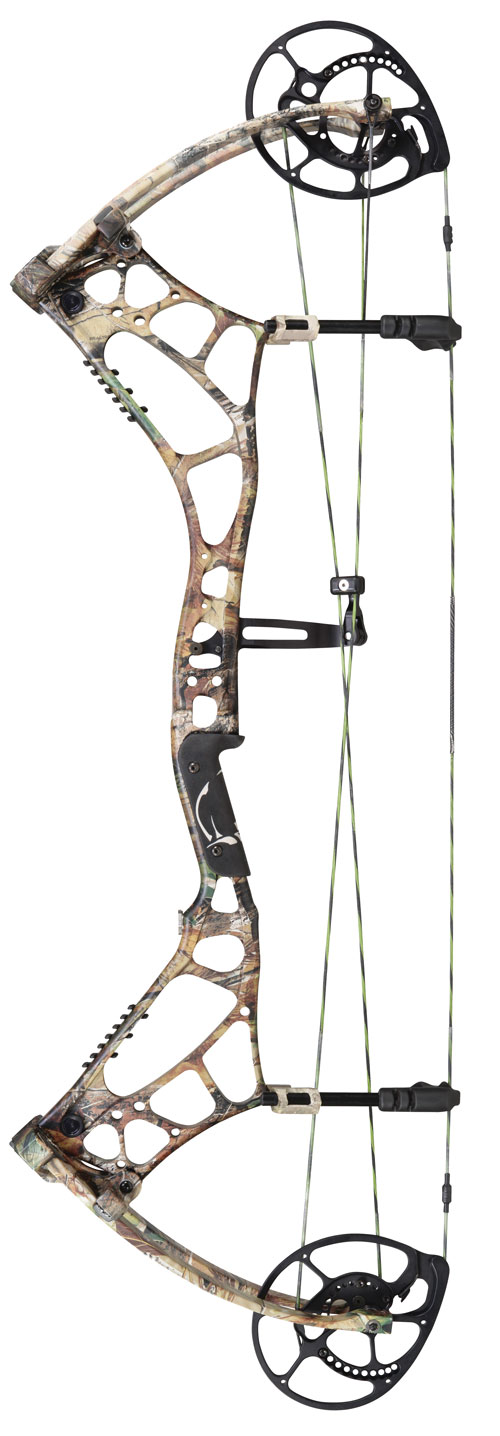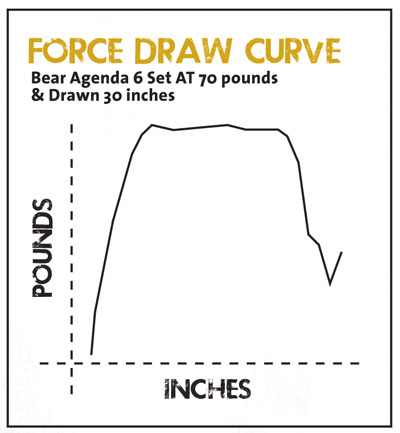Bear engineers have developed no fewer than eight different cam systems in recent years, including twin cams, hybrid cams, and single cams, each designed to fit a particular bow or to produce a desired amount of speed or shootability. At the heart of the Agenda 6 is Bear’s now-familiar hybrid system, the H13. It is a hallmark of Bear’s cams that they allow draw lengths to be adjusted without use of a press and, in most (though not all) cases, without changing modules. This is a real plus for the inexperienced shooter who may be (and probably should be) experimenting to find his sweet spot, or for the experienced shooter who finds that his sweet spot on one bow is not necessarily identical to that on another bow and insists on tweaking draw length to get it perfect.
Bear bows have a distinctive look about them—long, moderately reflexed risers, short limbs, big cams, narrow overmolded grips with the Bear logo in white. The basic look remains the same, but some new technology has changed the appearance slightly. The new bilaterally adjustable string stops lend a sleeker if less aggressive appearance to the bow, and the same can be said for the new cable guard system. Dubbed the Bear Hinge Guard, it mounts from the center of the riser (actually extending through it) and features a unique hinge design to move cables in as the bow is drawn and back out to provide adequate fletching clearance at the critical part of the shot cycle. The idea, as with similar designs that change the position of the cables through the shot cycle, is to reduce torque.
 Newly designed limb pockets contribute to a lighter, skinnier look for Bear’s newest bows as well. A more subtle change is represented by the sound and vibration dampener strips that, like the Bear Hinge Guard, are actually integrated into the riser, in this case being inserted in the face of the riser near each limb pocket. With the exception of the radically different cable guard, these are all incremental changes; still, aesthetics aside (and I happen to find them aesthetically pleasing), all were developed to result in improved performance.
Newly designed limb pockets contribute to a lighter, skinnier look for Bear’s newest bows as well. A more subtle change is represented by the sound and vibration dampener strips that, like the Bear Hinge Guard, are actually integrated into the riser, in this case being inserted in the face of the riser near each limb pocket. With the exception of the radically different cable guard, these are all incremental changes; still, aesthetics aside (and I happen to find them aesthetically pleasing), all were developed to result in improved performance.
The draw weights of Bear bows cover the typical 10-pound range, and in this case changing draw weight entails loosening set screws under each limb pocket, turning the limb bolts, and retightening the set screws. The limb bolts require a 7⁄32 hex head, which is a little larger than most. These are not by any means unusual or hard to find, but some hex sets don’t include that size. They arguably offer an advantage in extra leverage, which may make stripping the bolt less likely.
I already mentioned the draw length adjustment. A corresponding draw stop must be repositioned to correspond to any change in draw length. I played with it just to test it; it’s a great setup that even the most casual shooter can adjust easily and safely.
Fit and finish, as you might expect from a Bear Bow, was excellent on the model tested.
Shooting The Bow
When you set up a lot of bows, you appreciate things that make the process quick, easy, and foolproof. Like the fact that virtually every rest seems to fit well on a Bear bow. Like being able to find centershot by placing an arrow against the riser at the Berger holes and moving the rest in and out until an arrow in the rest is parallel for its entire length with the arrow against the riser. Doing that, and squaring the arrow to the string when it was centered even with the Berger holes, I’ve been able to get great arrow flight from Bear bows, this one included, without further adjustments—just sight in and go.
I hesitate to describe bows as accurate or forgiving, since virtually any bow can be shot accurately by a shooting machine or an expert shot, and since forgiveness tends to be very subjective. So I’ll just say that I had no difficulty shooting bull’s-eyes with this bow, and that it was for me easier than many bows to hold steady on the target. I’ll say also that the speed was evident before confirming it with tests. With an IBO rating of 350 fps, the arrow gets from here to there in a hurry. Finally with regard to speed I’ll also comment that, though bows set up for hunting almost never match IBO ratings for a number of reasons, Bear bows tend to come closer to their ratings than is the case for many bows.
The grip on Bear bows is narrow, ergonomic, and comfortable. It can be removed for those who prefer something even skinnier (there are sideplates beneath the removable grip), but though I generally prefer a slick grip, I tend to like the Bear grips and leave them in place.
At 3.9 pounds I would not characterize this as a light bow by current standards, but it certainly isn’t heavy. It balances well (a little top-heavy, like the great majority of compound bows) and with the warm grip is a comfortable carry.
At 350 fps, this is a very fast bow. Despite that, it can fairly be described as smooth-drawing. The cam has a slightly aggressive feel, and there is a slight bump as it drops into the valley and against the wall. In a similar vein, there is a barely noticeable vibration after the shot. Still, any shooter who experiences this bow as very aggressive or harsh is overbowed. Speed doesn’t come free. But the shooter shooting at a comfortable draw weight will find that, though speed doesn’t come free, in the case of a well-engineered bow like the Bear Agenda 6, it can be very inexpensive.
Bear Agenda 6 specs
Letoff:.................................... 75%
Brace Height:.................... 6 inches
Weight:................................... 3.9 pounds
Axle-To-Axle Length:. 32 inches
Speed:....................................... 350 fps
Draw Weights:.................. 50, 60, and 70 pounds, adjustable down 10 pounds from peak.
Draw Lengths:.................. 251⁄2 to 30 inches, module-specific in half-inch increments.
Options:................................ Realtree APG, Shadow Series finishes.
Suggested Retail: $900
Objective Tests (30 Inches Draw)
Peak Hold*:............................ 70 pounds
Weight, Full Draw*:........... 20.5 pounds
* Rounded to nearest half-pound
At 70-Pound Draw Weight
Arrow Weight Speed @ Launch Speed @ 20 Yards K.E. @ Launch K.E. @ 20 Yards Sound Level
385 grains 325 fps 312 fps 90.0 ft. lbs. 83.0 ft. lbs.
500 grains 290 fps 284 fps 93.0 ft. lbs. 89.5 ft. lbs.
At 60-Pound Draw Weight
385 grains 301 fps 291 fps 77.5 ft. lbs. 72.0 ft. lbs. 58.9 dBA
500 grains 267 fps 262 fps 79.0 ft. lbs. 76.0 ft. lbs. 47.7 dBA







